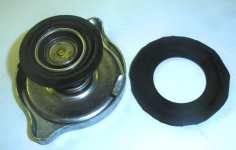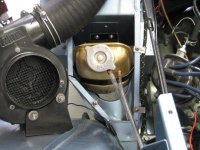Re: Anti-Frezze expandtion thru overflow @ Shutdown
Moss sells a brass tube designed to block the bypass the port discussed earlier. This "blanking sleeve" is pricey at almost $15, part No. 434-135. It fulfills the function of the skirt on those very expensive skirted thermostats. I installed this bit and found no problem having a 160-degree thermostat nestles inside it. I have also fabricated a thin sheet aluminum surround around the top and sides of my recored radiator, making it in two pieces that join under the fan protection piece on the back of the radiator. It is secured at the top of each side by the radiator bolts. Rather than having to remove the bolts each time I want to remove this aluminum surround, I simply notched around the bolts. Tightening the bolts pinches the pieces (two about 3" wide on either side and joined at the top as described) firmly in place. I also notched the bottom of each side piece to mate over the frame member that runs directly behind the radiator. I have added another wrinkle picked up at the Tamp Bay area Brit car show, shimming the bottom of the radiator forward away from the earlier mentioned frame member. I used about 1" long pieces of electrical conduit held in place by the top radiator attachment bolts on each side. The idea is to allow more air flow between the bottom radiator tank and the frame member. This does require longer bolts at the bottom, and is hardly noticeable upon inspection. Does it work? Don't know because I also added other "fixes" in the process. Finally, getting back to the original discussion, I used a flat-sided Heinz ketchup bottle for my overflow tank, cable tying it to the right side (viewed from the driver's seat) of the radiator. I ran the overflow hose into it, and run that bottle about half full of coolant. Since I now live in Florida, I will never be able to do enough to keep my 3000 cool. I've done all of the heat shields (see Healey6) and insulating. Next, I am going to try Steve G's air-blocking panels on either side of the radiator and the panels under the shroud described in Healey6 and earlier in this discourse. We have had a beastly summer, but I have not seen 212 degrees on my temp gauge. I don't let the car idle unnecessarily, however. Also, I have bypassed my heater motor, telescoped the front and rear nominal 4" hoses, detached the hose at the heater, and directed that hose and its cool air (when underway) just above the package shelf above the passenger seat.

 Hi Guest!
Hi Guest!

 smilie in place of the real @
smilie in place of the real @
 Pretty Please - add it to our Events forum(s) and add to the calendar! >>
Pretty Please - add it to our Events forum(s) and add to the calendar! >> 







